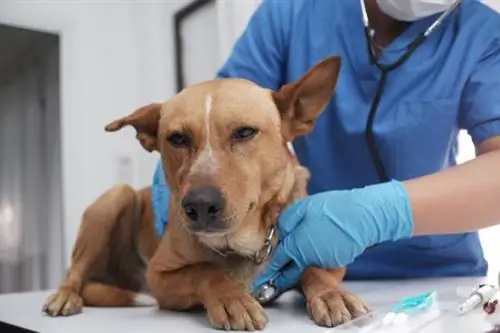- Author Carl Johnson [email protected].
- Public 2023-12-16 06:19.
- Last modified 2025-01-23 08:59.

If our dog appears with a swelling under the ears that reminds us of the mumps that people can get, we can ask ourselves: " Can my dog have mumps ?". The answer is yes, although it is not a frequent disease and this type of transmission is rare, our dog may have caught the virus that causes it in people, a virus related to the one that causes canine distemper disease that must sound so dog sitters.
What is mumps in dogs?
Mumps is called the inflammation of the parotid salivary glands (parotitis), which are V-shaped and located under each ear of our dog, at the base of the auricular cartilage. The canine major salivary glands consist of four glandular pairs: parotid, submandibular, sublingual, and zygomatic that control saliva production; in the cat a fourth pair is added, the molar glands. Saliva contains an enzyme called amylase that breaks down starch into glucose so that it can be used by the body, so the digestive process begins there.
In puppies, puppy mumps is called juvenile cellulitis, also called juvenile pyoderma or juvenile sterile granulomatous dermatitis. This disease affects dogs less than four months old and causes edema of the snout and periocular region, with pustules that crust over in the ear region that can affect the vertical portion of the ear canal, making the area thick and hot to the touch with possible development of otitis. The picture will progress to alopecia, hardening of the skin and later erosions and ulcers will appear on the snout and chin. There may be an increase in the mandibular lymph nodes that can ulcerate. Deep inflammation (cellulite) can damage hair follicles, leading to scarring.
Causes of mumps in dogs
Pathotitis in dogs can be due to:
- Traumatisms such as blows with inoculation of foreign bodies that can inflame and infect the gland.
- Secondary to other processes such as pharyngitis or salivary stones stuck in the parotid duct that produce catarrh of the same with inflammation of the gland. It can also be as a consequence of canine distemper disease.
- Sometimes this disease is caused by transmission of the virus that causes mumps in humans due to close contact with a person with the disease, is rare but there have been cases. People are the reservoir of the virus and it is transmitted through direct contact by aerosols, fomites or urine. In addition, it can also occur in cats.
The virus that causes mumps belongs to the same family as the disease known as canine distemper, a Paramyxoviridae, but unlike the genus to which distemper belongs, which is a Morbillivirus, the mumps virus mumps belongs to the Rubulavirus genus. It is an RNA virus that is isolated in saliva, cerebrospinal fluid, urine, brain, blood and other tissues.
Canine mumps symptoms
The mumps virus first locates in the parotid glands, causing a painful swelling of the glands with an increase in the area giving them the characteristic appearance of mumps. The affected dog will show the following clinical signs:
- Parotid inflammation more or less evident
- Redness and/or pus in the gland
- Hardening of the glands due to increased connective tissue
- Fever
- Pain
- Anorexy
- Decay
- Lethargy
- Weightloss
Depending on the severity of the process, the inflammation can extend to the submandibular glands and even affect the facial nerve, causing facial paralysis. In case of observing any of the symptoms of mumps in dogs, it is essential to go to the veterinarian.
Diagnosis of mumps in dogs
Mild parotitis may be confused primarily with inflammation of the immediate connective tissue or subparotid lymph nodes, especially if they have also been affected. With the ultrasound it is possible to differentiate mumps from other pathologies such as adenitis, abscesses or stones in the salivary ducts.
The diagnosis of this disease is mainly based on the history, that is, a medical history of the animal must be completed, when it began the process, if you have had an incident that could cause it or if you have been in contact with someone sick with mumps.
The next step will be the palpation of the area to determine the severity of the inflammation, if it is really an inflammation of the parotid or it is another process, as well as its spread to the immediate tissues and nerves.
Once it has been determined that it is a condition in the parotid glands, blood tests should be done on the dog:
- The blood count will show normal or decreased total leukocytes with an increase in lymphocytes.
- If the determination of serum amylase is increased from 269-1462 U/l, pathology of the salivary glands (parotitis or glandular stones) can be suspected, among other processes such as pancreatic disease, disease oliguric renal (poor urine production), intestinal or liver disorders.
Saliva, pharyngeal exudate or oral mucosa samples will be obtained and the genetic material of the virus will be isolated by PCR, or antibodies against other infections.

How to cure mumps in dogs? - Treatment
There is no specific medication available for mumps in dogs of viral origin, the treatment of mumps in dogs will be symptomatic, it is that is, to palliate the symptoms produced by the disease, such as:
- Antipyretics and anti-inflammatories to reduce fever and inflammation.
- Fluid therapy subcutaneous or intravenous if there is dehydration due to anorexia.
- Nutrition with soft, easy-to-eat foods and plenty of water.
If it is bacterial, apply antibiotics and abscesses should be drained early if they exist.
Forecast
In general, the prognosis is good and in less than two weeks they are usually cured Of course, it is necessary to go to a veterinary center so that they make the correct diagnosis to our dog and prescribe the best treatment, being able to use some home remedy, but always as a complement and not as a substitute for the veterinary consultation. As prevention, if someone in the family has mumps, you should also limit contact with your dogs or cats due to the risk of transmission to them.
Home remedies for mumps in dogs
Some remedies that could be used to relieve our dog a bit are apply cold cloths on the area, with or without substances with anti-inflammatory properties such as aloe vera or chamomile. Another remedy that can relieve some pain and inflammation due to its anti-inflammatory properties is a paste with fresh ginger root placed directly on the inflamed area.
Although these remedies can be excellent complements to veterinary treatment, we insist, it is very important to go to a professional to diagnose the disease and treat it.






